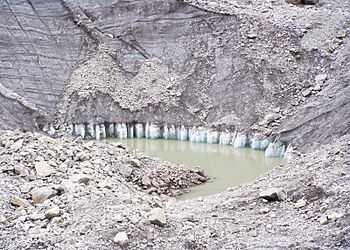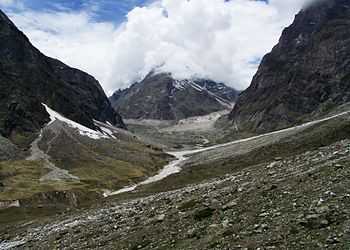Satopanth Tal
| Satopanth Trail | |
|---|---|
 Satopanth Tal | |
| Location | Uttarakhand, India |
| Trailheads | Badrinath to Satopanth Tal |
| Use | Hiking |
| Elevation | |
| Highest point | Satopanth Top |
| Lowest point | Badrinath |
| Hiking details | |
| Trail difficulty | Three star trek |
| Season | July to September |
| Sights | Mt. Nilkantha, Mt. Balakun, Satopanth Glacier, Bhagirath Kharak Glacier, Alakapuri |
Satopanth Tal is a lake in Uttarakhand, India, located in the midst of snow-capped peaks at an altitude of 4,600 metres (15,100 ft) above sea-level. The lake is considered to be of religious significance to the local people; residents of Mana village throw the ashes of the dead in the lake. There is a saint known as Moni Baba, for he had stopped talking from a very early time. There's common belief that he can live only on sun and air, if food is unavailable.
Popular Beliefs
Many people believe that the Trimoortis, viz, Brahma, Vishnu and Mahesh, take bathe in the lake in an auspicious day. Also some types of birds are found here, which pick up the pollutants of the lake and thus keep the lake clean. These birds are not found anywhere. The local belief is that they are the Gandharvas disguised, who guard the lake against evils.
Geography
Located in the midst of snow capped peaks at an altitude of 16,000' from sea-level, Satopanth Tal is 22 km ahead of Badrinath. Balakun Peak, Kuber Top, Mt. Nilkantha, and Mt. Swargarohini are the peaks visible en route. The lake remains under snow from the end of September to mid of May or sometimes end of June. The normal summer temperature remains around 12°C in day and 7°C to -5°C in night, while the winter temperature may drop to even -25°C in day and -36°C in night.[1]
| Nearest Village: Mana(about 18 km) |
| Nearest rail head: Rishikesh |
| Nearest Airport: Jolly Grant Airport |
Trek route
The trek to Satopanth starts from Mana, 3 km ahead of Badrinath. Crossing the river, we have to trek the regular trekking route to Vasudhara, the trail ascends higher and one sees Vasudhara Falls at a distance on the other bank of Alakananda River. Then crossing a dangerous glacier, the local name of which is Dhano Glacier, one reaches Laxmivan, 5 km ahead of Vasudhara. The night stay is done at caves or tents, which is very essential on the route. Laxmiban is 13 km from Badrinath. The next day, if one starts early they can reach Chakratirth 5 km ahead, by crossing the Dhano Glacier, at mid-day. After taking a nap, one should immediately st art for Sahasradara, 3 km ahead. The Satopanth Top from where Kuber Glacier, and Kuber Top is visible, is only 3 km from Sahasradhara. The back face of Mt. Nilkantha is visible from here. From here Satopanth Tal is only a 2 km trek.[2]
Essentials for Satopanth Tal trek
Firstly inner-line permit has to be taken from Joshimath. A guide, and experienced porters must be taken. There are no night stay places, a tent is required along with a stove and mattress. The trek route is a bit tough and only the experienced trekkers should undertake this trek. En route Laxmivan a glacier named Dhano Glacier has to be crossed and en route Chakratirth one knife-ridge has to be crossed. The trekkers must take necessary precautions like extra food.
Gallery
-
Towards Mana
-
Vasudhara Falls en route Laxmivan
-
View of Balakun from Vasudhara Falls
-
Dhano Glacier en route
-
Crossing a ridge en route Chakratirth
-
The ridge en route
-
Near Satopanth Tal
-
Satopanth Tal
References
External links
- http://www.uttaranchal.org.uk/uforums/viewtopic.php?f=15&t=268
- http://trekwords.wordpress.com/2008/11/05/on-the-bank-of-satopanth/
| ||||||||||||||||||||






